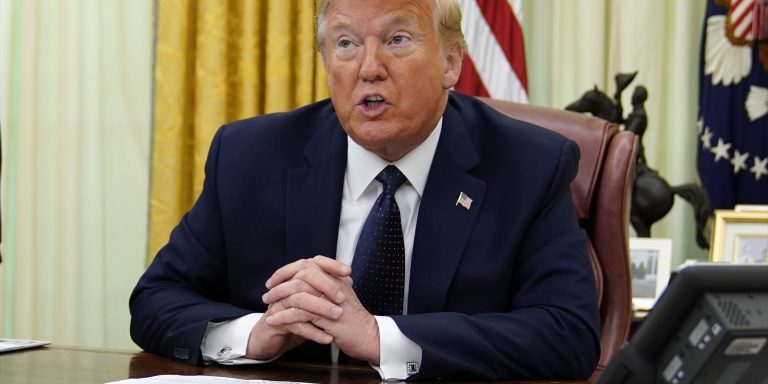INTELBRIEF
June 3, 2020
IntelBrief: President Trump and Twitter on a Collision Course

- The status quo of applying different rules to world leaders online changed when Twitter labeled some of President Trump’s tweets as inaccurate and flagged others for violating rules against glorifying violence.
- In response to having his May 26, 2020 tweet labeled as factually inaccurate, President Trump signed a new Executive Order to fight perceived anti-conservative bias within social media companies.
- By most accounts, the new Executive Order is toothless, yet even if implemented, it would be unlikely to survive further judicial scrutiny.
- With America suffering from racial injustice, a devastating pandemic, and world leaders stoking the fires of discontent, social media companies have an important responsibility to ensure that their platforms are not used as a siren call for malevolent actors, both within the United States and abroad.
On May 28, 2020, President Trump signed an unprecedented Executive Order (E.O.) on ‘Preventing Online Censorship.’ During the pandemic, social media has been awash in a toxic mix of misinformation, disinformation, conspiracy theories, and false COVID-19 remedies. The result has been calls for stricter content moderation efforts by social media companies, especially as Chinese and Russian initiatives amplify U.S.-based anti-government and white supremacy groups’ use of online platforms to instigate violence against minorities. President Trump regularly uses social media to peddle dangerous conspiracies and misinformation. Against this backdrop, Twitter flagged the President’s May 26, 2020 tweet, which falsely claimed that mail-in voting will increase voter fraud. Twitter has removed or flagged false information from high-level political figures before, recently removing tweets made by Brazilian President Jair Bolsonaro when he questioned the efficacy of quarantine measures adopted to stem the spread of the novel coronavirus. Historically, Twitter and other social media companies have provided significant latitude to political leaders, including sanctioned Iranian senior officials using their platforms. Yet, until Twitter’s recent decisions, many of these political elites had been given more leeway in violating the terms of use, internal policies, and community and safety standards adopted by mainstream social media companies.
President Trump’s new E.O. is part of a broader effort to curb any perceived criticism of him, his policies, or his fabricated narratives designed to shift public sentiment. Another underlying impetus behind the President’s new order is the charge that Twitter, Facebook, Instagram, and YouTube have an anti-conservative bias that leads to content removal over their platforms that disproportionately removes conservative posts, tweets, pictures, or videos. While social media companies have adopted an inconsistent and sometimes arbitrary approach to content removal, there are no credible studies that indicate that mainstream social media companies possess anti-conservative leanings. Silicon Valley is far from a monolith, its inherent ‘bro culture’ and susceptibility for allowing white supremacist theories to proliferate are decidedly illiberal. Andrew Anglin, the publisher of the neo-Nazi Daily Stormer, has opined that he gets monetary support from Silicon Valley residents and that his website’s most significant traffic came from California’s Santa Clara County – home to major internet companies.
Turning to the practicalities of the President’s E.O., most legal observers assert that it is more of an upbraiding of social media companies than an order that could limit many of the legal protections emanating from Section 230 of the Communications Decency Act (CDA). The CDA shields social media companies from liability for the content posted on their sites. Court decisions have also largely pushed back on efforts to rein in initiatives to treat companies like Twitter, YouTube, and Facebook as publishers, instead of platforms which may moderate content without being sued. The new Executive Order does two primary things. First, it directs the Secretary of Commerce to request that the Federal Communications Commission (FCC) evaluate rulemaking, inter alia, regarding social media company liability. Second, it encourages the Federal Trade Commission (FTC) to evaluate complaints of bias and otherwise determine whether there is an unfair restriction of free speech by social media companies. The FCC and FTC are both independent agencies and are not obligated to follow-through on the President’s request. However, if the unlikely transpires and Trump’s E.O. results in new regulations and implementation, the FCC and FTC would serve as de facto police forces with responsibility for monitoring social media companies. If implemented, it is unlikely that the order would survive scrutiny pursuant to applicable law under the CDA, or the First Amendment. Legal scholars have also questioned whether the order would violate the companies’ First Amendment rights to fact check what is on their own platforms. President Trump alleges that Twitter is violating his right to free speech. This notion is legally fraught since the Constitution’s First Amendment is designed to prevent Congress from abridging the freedom of speech. Unlike the Federal Government, Twitter is a private company and is not bound to the tenets of the First Amendment. While Section 230 of the CDA is outdated and worth re-examining, the U.S. Congress should take the lead on amending it.
As demonstrations and protests continue to spread throughout the United States, President Trump has used the very social media he disparages to threaten protesters and rally his supporters, further dividing the country. On May 29, Twitter hid and labeled a President Trump tweet as having ‘glorified violence.’ Following the protests, demonstrations, and riots in Minneapolis stemming from the murder of George Floyd, President Trump tweeted, ‘when the looting starts, the shooting starts.’ The President’s deliberately inflammatory tweet – the origins of which trace back to a racist Miami police chief whose tactics terrorized blacks in the 1960s – exacerbated tensions, as he intended. With America enveloped in chaos due to suffering from racial injustice, a devastating pandemic, and world leaders stoking the fires of discontent, social media companies have an important responsibility to ensure that their platforms are not used as a siren call for malevolent actors, both within the United States and abroad.
.
For tailored research and analysis, please contact: info@thesoufancenter.org